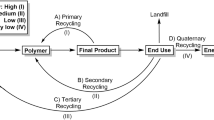Abstract
The sustainability of biodegradation reactions is of interest at Type 1 chlorinated solvent sites where monitored natural attenuation is being considered as a remedial alternative. Type 1 chlorinated solvent sites are sites undergoing reductive dechlorination where anthropogenic substrates (such as landfill leachate or fermentable organics in the waste materials) ferment to produce hydrogen, a key electron donor. A framework is provided that classifies Type 1 chlorinated solvent sites based on the relative amounts and the depletion rates of the electron donors and the electron acceptors (i.e., chlorinated solvents). Expressions are presented for estimating the total electron donor demand due to the presence of solvents and competing electron acceptors such as dissolved oxygen, nitrate, and sulfate. Finally, a database of 13 chlorinated solvent sites was analyzed to estimate the median and maximum mass discharge rate for dissolved oxygen, nitrate, and sulfate flowing into chlorinated solvent plumes. These values were then used to calculate the amount of hydrogen equivalents and potential for lost perchloroethylene (PCE) biodegradation represented by the inflow of these competing electron acceptors. The median and maximum mass of PCE biodegradation lost due to competing electron acceptors, assuming 100% efficiency, was 226 and 4621kgyear−1, respectively.
Similar content being viewed by others
References
Aziz CE, Newell CJ & Gonzales JR (1999)BIOCHLOR Chlorinated Solvent Plume Database Report. Air Force Center for Environmental Excellence,Brooks AFB, TX
Farhat SK, de Blanc PC, Newell CJ & Gonzales JR (2004) SourceDK Remediation Timeframe Decision Support System, User 's Manual. Air Force Center for Environmental Excellence,Brooks AFB, TX
He J, Sung Y, Dollhopf ME, Fathepure BZ, Tiedje JM & Loffer FE (2002)Acetate versus hydrogen as direct electron donors to stimulate the microbial reductive dechlorination process at chloroethene-contaminated sites. Environ. Sci. Technol.36:3945–3952
Kennedy L, Everertt J & Gonzales J (2002)Aqueous and Mineral Intrinsic Bioremediation Assessment (AMIBA) Protocol,Draft. Air Force Center for Environmental Excellence,Brooks AFB, TX
National Research Council (2000)Natural Attenuation for Groundwater Remediation. National Academy Press, Washington,DC
Newell CJ, Aziz CE, Haas PE, Hughes JB & Khan TA (2001a) Two novel methods for enhancing source zone bioremediation. In:Magar V, Fennell D, Morse J, Alleman B & Leason A (Eds)Direct Hydrogen Addition and Electron Acceptor Diversion,Anaerobic Degradation of Chlorinated Solvents (pp 19–26). In Situ and On-Site Bioremediation: The Sixth International Symposium. Battelle Press, Columbus,OH
Newell CJ, Aziz CE & Cox GA (2001b)Novel method to enhance chlorinated solvent biodegradation by the use of barriers. In:2001 International Containment and Remediation Technology,Conference and Exhibition,Orlando, Florida,June 10-13,2001
US Environmental Protection Agency (1999)Use of Monitored Natural Attenuation at Superfund,RCRA Corrective Action,and Underground Storage Tank Site,O ce of Solid Waste and Emergency Response (OSWER),Directive 9200. 4-17P,Final Draft,Washington,DC,April 21, 1999
Wiedemeier TH, Rifai HS, Newell CJ & Wilson JT (1999) Natural Attenuation of Fuel Hydrocarbons and Chlorinated Solvents. John Wiley, New York
Yang Y & McCarty PL (2002)Comparison between donor substrates for biologically enhanced tetrachloroethene DNAPL dissolution. Environ. Sci. Technol.36(15):3400–3404
Rights and permissions
About this article
Cite this article
Newell, C.J., Aziz, C.E. Long-Term Sustainability of Reductive Dechlorination Reactions at Chlorinatedsolvents Sites. Biodegradation 15, 387–394 (2004). https://doi.org/10.1023/B:BIOD.0000044682.92391.bb
Issue Date:
DOI: https://doi.org/10.1023/B:BIOD.0000044682.92391.bb




